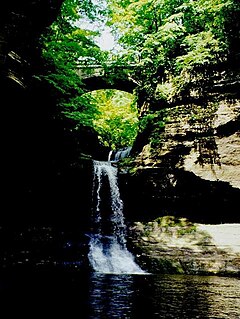
Quercus velutina, the black oak, is a species of oak in the red oak group, native and widespread in eastern and central North America. It is found in all the coastal states from Maine to Texas, inland as far as Michigan, Ontario, Minnesota, Nebraska, Kansas, Oklahoma, and eastern Texas. It is sometimes called the eastern black oak.

Matthiessen State Park is an Illinois state park located a few miles south of the more famous Starved Rock State Park. The main entrances to both parks are located on Illinois State Route 178.

Fraxinus velutina, the velvet ash, Arizona ash or Modesto ash, is a species of Fraxinus native to southwestern North America, in the United States from southern California east to Texas, and in Mexico from northern Baja California east to Coahuila and Nuevo León.

Leucozona is a genus of hoverflies. Species within this genus typically have a variegated pattern of dull and bright colours on the thorax and abdominal segments such as white or even blue. This colouration allows the hoverfly to mimic more predaceous bees and wasps, for example Leucozona lucorum.

The Asian hornet, also known as the yellow-legged hornet or Asian predatory wasp, is a species of hornet indigenous to Southeast Asia. It is of concern as an invasive species in some other countries.

Erythrina velutina is a species of leguminous tree. It is indigenous to Brazil, Peru, Ecuador, Colombia, Venezuela, and Hispaniola and has been introduced to much of the Caribbean, Uganda, and Sri Lanka. It also occurs on the Galápagos Islands, but whether it is indigenous or introduced there is unclear. In Brazil, it occurs on plains and near rivers in the arid parts of the northeast of the country and is commonly known as "mulungu". Erythrina velutina grows as a large tree to around 10 m (30 ft) high and has short spines on the stem. It is perennial.

Belloliva is a genus of sea snails, marine gastropod mollusks in the family Bellolividae.

Chukrasia tabularis, the Indian mahogany, is a deciduous tree, which is a monotypic genus in the family Meliaceae. It is native to Bangladesh, Cambodia, China, India, Indonesia, Laos, Malaysia, Myanmar, Sri Lanka, Thailand, and Vietnam. Also introduced to many western countries such as Cameroon, Costa Rica, Nigeria, Puerto Rico, South Africa, and United States. The plant is widely used in Ayurveda as an important medicinal plant.

Velutina is a genus of small sea snails, marine gastropod mollusks in the family Velutinidae.

Cydalima perspectalis or the box tree moth is a species of moth of the family Crambidae, first described by Francis Walker, the English entomologist, in 1859. Native to Japan, China, Taiwan, Korea, far-east Russia and India, it has invaded Europe; first recorded in Germany in 2006, then Switzerland and the Netherlands in 2007, Great Britain in 2008, France and Austria in 2009, Hungary in 2011, then Romania, Spain and Turkey. It is been seen in Slovakia, Belgium and Croatia,
Heliciopsis velutina is a species of trees, in the family Proteaceae. They grow up to 25 metres (80 ft) tall, with a trunk diameter of up to 25 cm (10 in). The bark is dark brown. They have reddish brown flowers. They have brown, ellipsoid fruits up to 4 cm (2 in) long. The specific epithet velutina comes from the Latin meaning "velvety", referring to the petiole. They grow naturally in lowland mixed dipterocarp forests' habitats from sea level to 600 metres (2,000 ft) altitude in Peninsular Malaysia and Borneo.

Ashmeadiella is a genus of bees in the family Megachilidae. There are more than 60 described species in Ashmeadiella.
Macrothemis imitans, the ivory-striped sylph, is a species of skimmer in the dragonfly family Libellulidae. It is found in Central America, North America, and South America.
Leucozona xylotoides is a species of syrphid fly in the family Syrphidae.
Eucerceris is a genus of wasps in the family Crabronidae. There are more than 40 described species in Eucerceris.
Anchycteis is a genus of toe-winged beetles in the family Ptilodactylidae. There is one described species in Anchycteis, A. velutina.

Paranomada velutina is a species of cuckoo bee in the family Apidae. It is found in Central America and North America.

Paranomada is a genus of cuckoo bees in the family Apidae. There are at least three described species in Paranomada.
Pholeomyia is a genus of freeloader flies in the family Milichiidae. There are more than 30 described species in Pholeomyia.











